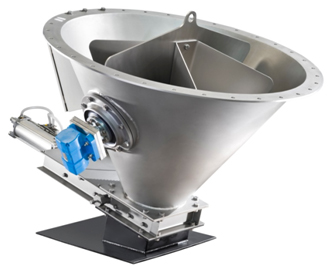Working with hard-running materials
Many dry bulk materials possess physical properties, which lead to quick caking and lumping during storage. The main hindrance for unloading of a hard-running material is the formation of hardened spots, arches, and so-called rat holes in the chamber of a hopper or a silo.

The resolution of the caked product unloading problem is of great significance from the point of view of enterprise productivity improvement.
To intensify the unloading of hard-running materials, the Prosystems company suggests using a vibration cone as the unloading device for all types of bulk materials: hard-running and arch-forming, dry, powdery, and granular. Its main advantage compared to aeration systems is the ability to prevent material fluidization, which has a positive effect on some types of bulk materials when they are packed into bags or loaded into silo vehicles. The flange design with a 60º inclination of the discharge opening allows for easy mounting the cone on any silo or hopper even after they have been installed.
![]()
A vibration cone allows for the maximum efficiency of working with hard-running materials, which will substantially reduce the costs and enhance the production effectiveness in the construction, chemical, food-manufacturing, and other industry branches

![]() ADVANTAGES
ADVANTAGES
OPERATING PRINCIPLE:
The vibrator's oscillations are transmitted to the vibration chute directly via the vibration elements, thus putting it in motion. As the result of this, the bulk material becomes loose, the arches crumble, allowing for the material’s discharge.
Production workers often use additional vibration of the silo walls with the aid of improvised вибрирующих устройств to stimulate the flow. Such actions lead to destruction of welded joints, violation of connecting joints’ air tightness, broken supports and mountings, which leads to silo damage. Such an accident may result in substantial financial losses for the enterprise, and probably fatal accidents as well.
![]()
Attention! Installation of the vibration element directly on the silo body may provoke critical damage to the construction and cause an emergency situation.
